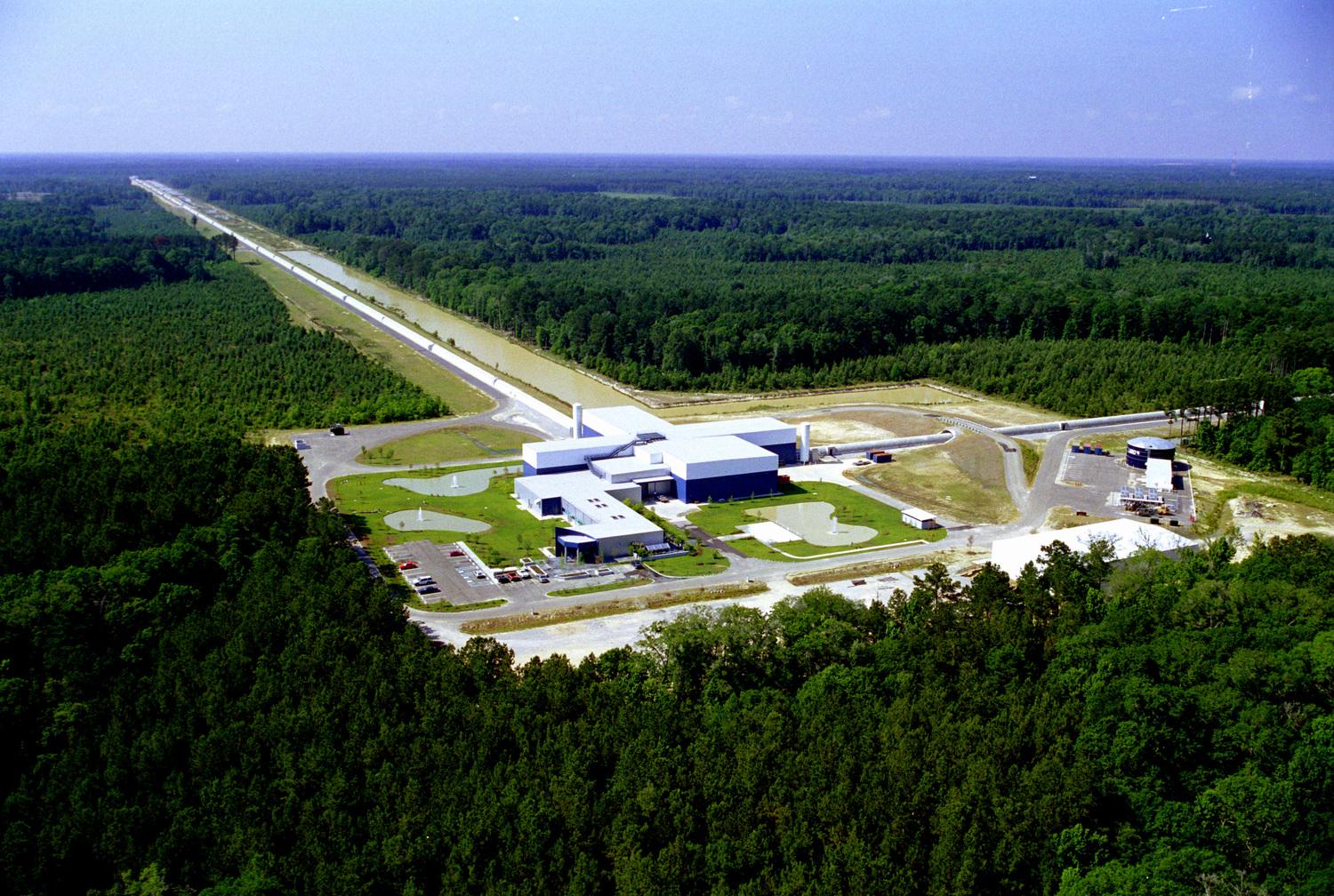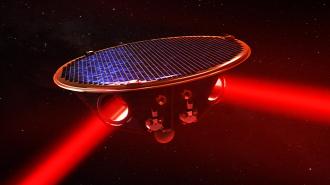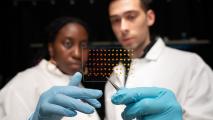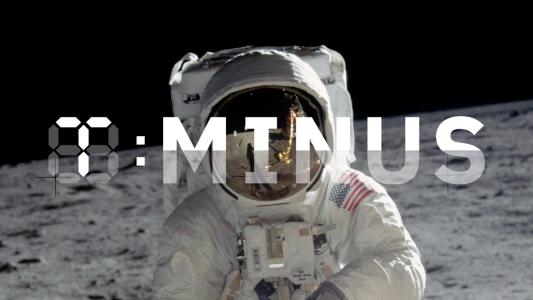This article is an installment of Future Explored, a weekly guide to world-changing technology.
This week, Freethink’s sister site Big Think is diving into the history of the universe, so we decided to dedicate this edition of Future Explored to LISA — a first-of-its-kind spacecraft that may uncover events that took place at the dawn of time.
You can get stories like this one straight to your inbox every Thursday morning by subscribing here.
The European Space Agency (ESA) has approved the world’s first space-based gravitational wave detector. Once launched, it will use three laser-shooting spacecraft to hunt for tiny ripples in spacetime — and hopefully give us an unprecedented look into the universe’s past.
“Gravitational waves carry information that you can’t get from any other way,” said physicist David H. Reitze. “A supernova, two neutron stars colliding, even the Big Bang itself — the beginning of the universe — all produce gravitational waves.”
Gravity 101
To understand gravitational waves starts with understanding gravity, so…
In 1687, Issac Newton published his law of universal gravitation, which stated that every particle that has mass attracts every other particle that has mass and that the strength of this attraction, which he called the force of gravity, would depend on two factors.
One was mass: a bigger object containing many particles would have a stronger gravitational pull than a smaller object. The other was distance: the closer two objects are to one another, the stronger the force of gravity between them and vice versa.
Obvious example: you are less massive than Earth, so Earth’s gravity is stronger than yours (although, yes, you do exert some gravity on the Earth). As a result, you are reliably stuck to the Earth’s surface. If you were to travel far away from the Earth, though, you’d need very little energy to overcome its gravitational pull and so effectively break free from it.
Looking at this on a larger scale, objects that orbit one another in space do so because they’re just the right size, distance, and velocity relative to one another to pull at each other without colliding or one of the objects floating away. It’s a kind of celestial equilibrium.
Massive, accelerating objects create tiny ripples in spacetime that Einstein called “gravitational waves.”
Einstein took this concept to the next level (like he did pretty much everything related to physics) with the publication of his theory of general relativity, which suggested that the reason objects have gravity is because their mass is actually curving spacetime.
The common analogy to explain this is a bowling ball sitting on a trampoline.
The ball represents a massive object, while the trampoline represents spacetime being warped by the object. If you were to toss a smaller object, like a marble, near the bowling ball, it would roll down toward it, as the mass of the bigger object curves spacetime.
Gravitational Waves
Einstein later built on this idea by proposing that massive, accelerating objects — such as two black holes orbiting one another — create tiny ripples in spacetime, sort of like if you were bouncing on the trampoline.
He called these ripples “gravitational waves” and proposed that they were constantly stretching and compressing everything in the universe. He also predicted that we’d never actually be able to detect them, but that didn’t stop scientists from trying — the potential reward was simply too good not to try.
“Gravitational waves bring the information from the birth of the universe to us today.”
Kip Thorne
Throughout history, all the information we’d collected about the universe’s past had been in the form of electromagnetic waves — visible light, infrared, radio waves, etc. — which travel at a speed of 186,000 miles per second in a vacuum.
That’s incredibly fast, but because the universe is so huge, it still takes a long time for the waves emitted from a distant object (like a star or galaxy) to reach us on Earth. That means when we study the waves from something far away, we’re really seeing what it looked like a long time ago, when the waves started their journey.
Studying super distant objects can help us understand what the universe was like long ago, but electromagnetic waves can be distorted or outright blocked by other closer objects and forces on their way to Earth, which interferes with our ability to learn from them.
Gravitational waves travel just as fast as electromagnetic waves, but they can’t be blocked or distorted along their journey, which means they could reveal parts of the universe’s past that are impossible to study otherwise.
“[G]ravitational waves created at the very birth of the universe travel unscathed through all the hot matter of the early universe, as the universe expanded,” astrophysicist Kip Thorne told the National Science Foundation (NSF). “They didn’t scatter. They didn’t get absorbed. They bring the information from the birth of the universe to us today.”

Thorne ended up earning a Nobel Prize in Physics for his contributions to the NSF-funded Laser Interferometer Gravity-Wave Observatory (LIGO), which proved Einstein right (about the theory) and wrong (about technology) in 2015 when it detected a gravitational wave for the first time.
The observatory consists of two facilities — one in Louisiana and one in Washington state. At each facility, a laser beam is split in two and shone through two perpendicular vacuum tubes, each about 2.5 miles long. After bouncing off mirrors at the ends of the tubes, the beams travel back down them, merge, and hit a detector.
If a gravitational wave goes by during this process, its compression/expansion effect on the mirrors actually changes the distance each beam travels slightly — very slightly. We’re talking about a change in distance of just one-thousandth the diameter of an atom’s nucleus, but LIGO can detect it.
(The purpose of having two facilities is so that they can perform experiments in unison, confirming that any “evidence” of gravitational waves detected at one isn’t a fluke.)
The gravitational wave LIGO detected in 2015 was caused by a collision between two black holes 1.3 billion light years away, and since then, more than 90 other waves have been detected, caused by colliding neutron stars, merging black holes, and other energetic phenomena.
Ground-based gravitational wave detectors have size and sensitivity limitations, though.
While they can detect waves caused by mergers between black holes a few dozen times as massive as the sun, for example, they can’t detect the low-frequency waves created by mergers between supermassive black holes, like those at the center of galaxies.
That means they can’t see a complete picture of the universe’s many wave-causing phenomena.
“We will probe gravitational waves of lower frequencies than is possible on Earth, uncovering events of a different scale, all the way back to the dawn of time.”
Nora Lützgendorf
Introducing LISA
Now, ESA is preparing to launch LISA — the world’s first space-based gravitational wave detector — by the mid-2030s.
“The reason we want to go to space is because we can make the detector much, much bigger, and by making it much, much bigger, we can actually access different kinds of gravitational waves, different wavelengths,” Ira Thorpe, a LISA project scientist, told NASA’s Curious Universe podcast.
LISA will consist of three spacecraft that will trail the Earth as it orbits the sun. They’ll be positioned about 1.5 million miles from each other, in a giant equilateral triangle, and inside each spacecraft will be free-floating golden cubes.
By shining lasers back and forth between the spacecrafts’ cubes, scientists will be able to precisely measure the distances between them — and just like with LIGO, they’ll be able to use changes in the distances to confirm the passing of gravitational waves.
The difference is that LISA will be able to detect lower-frequency waves — such as the ones caused by mergers between supermassive black holes, ones equal in mass to a few hundred million suns — giving us a new perspective into the universe’s past.
“Thanks to the huge distance traveled by the laser signals on LISA, and the superb stability of its instrumentation, we will probe gravitational waves of lower frequencies than is possible on Earth, uncovering events of a different scale, all the way back to the dawn of time,” said Nora Lützgendorf, LISA’s lead project scientist.
We’d love to hear from you! If you have a comment about this article or if you have a tip for a future Freethink story, please email us at [email protected].





